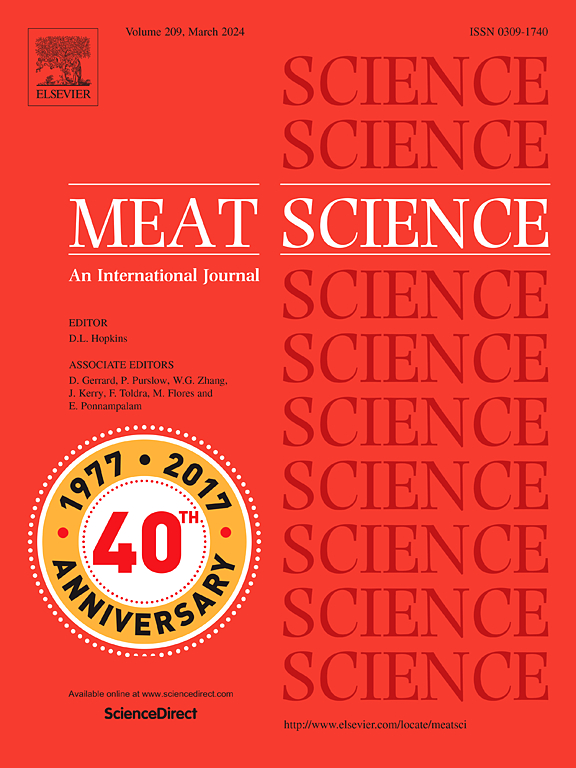Effect of by-products-based diet and intramuscular fat content on volatile compounds from pork
IF 7.1
1区 农林科学
Q1 Agricultural and Biological Sciences
引用次数: 0
Abstract
This study evaluated the effects of a fibre- and fat-rich by-products-based diet and the intramuscular fat (IMF) content on volatile compounds in pork. Meat samples were collected from sixteen gilts included in a feeding trial. Half of the animals were fed a conventional diet based on wheat, maize, barley and soybean meal, whereas the other half were fed a by-products-based diet that contained corn germ meal, malt sprouts, crispbread meal and proticorn, but no cereals or soya. Within each dietary treatment, four meat samples were selected from pigs in the upper quartile of IMF content (average 2.40 % ± 0.18 %, n = 8) and four from the lower quartile of IMF content (average 1.45 % ± 0.10 %, n = 8). SPME-GC–MS was used to evaluate the volatile profile of pork. A total of 45 volatile compounds were identified in the cooked pork samples. Aldehydes were the predominant chemical class in terms of the number of identified volatile compounds. No diet × IMF interaction was observed for the abundance of volatile compounds. Dietary treatment and IMF content significantly influenced the abundance of one and two aldehydes, respectively. Hexanal was more abundant in the meat of animals fed the conventional diet compared to the diet based on by-products. Tridecanal and tetradecanal were less abundant in pork with higher IMF levels. As precursors of volatile compounds, fatty acids were also analysed in the raw meat samples by GC. The concentrations of most fatty acids were higher in pork with higher IMF content but were not affected by diet. In conclusion, the volatile compounds profile of pork was only marginally affected by IMF content and feeding a by-products-based diet in the present study.
以副产品为基础的饲粮和肌内脂肪含量对猪肉挥发性化合物的影响。
本研究评估了以富含纤维和脂肪的副产品为基础的饮食和肌内脂肪(IMF)含量对猪肉挥发性化合物的影响。在饲养试验中,从16头后备母猪身上采集肉类样品。其中一半的动物被喂食以小麦、玉米、大麦和豆粕为基础的传统饮食,而另一半动物被喂食以副产品为基础的饮食,其中包括玉米胚芽粕、麦芽芽、脆饼粕和原玉米粉,但不含谷物或大豆。在每个饲粮处理中,选取IMF含量上四分位数(平均2.40%±0.18%,n = 8)和下四分位数(平均1.45%±0.10%,n = 8)的4个猪肉样品,采用SPME-GC-MS法评价猪肉的挥发性特征。在煮熟的猪肉样本中共检出45种挥发性化合物。就鉴定出的挥发性化合物的数量而言,醛类是主要的化学类别。饲粮与IMF对挥发性化合物丰度无交互作用。饲粮处理和IMF含量分别显著影响一醛和二醛的丰度。与以副产品为基础的饲料相比,以传统饲料喂养的动物的肉中己醛含量更高。三通和四通在猪肉中的含量越少,IMF水平越高。脂肪酸作为挥发性化合物的前体,也在生肉样品中进行了气相色谱分析。在IMF含量较高的猪肉中,大多数脂肪酸的浓度较高,但不受日粮的影响。综上所述,在本研究中,猪肉的挥发性化合物特征仅受IMF含量和饲喂副产品为主的日粮的轻微影响。
本文章由计算机程序翻译,如有差异,请以英文原文为准。
求助全文
约1分钟内获得全文
求助全文
来源期刊

Meat Science
工程技术-食品科技
CiteScore
12.60
自引率
9.90%
发文量
282
审稿时长
60 days
期刊介绍:
The aim of Meat Science is to serve as a suitable platform for the dissemination of interdisciplinary and international knowledge on all factors influencing the properties of meat. While the journal primarily focuses on the flesh of mammals, contributions related to poultry will be considered if they enhance the overall understanding of the relationship between muscle nature and meat quality post mortem. Additionally, papers on large birds (e.g., emus, ostriches) as well as wild-captured mammals and crocodiles will be welcomed.
 求助内容:
求助内容: 应助结果提醒方式:
应助结果提醒方式:


